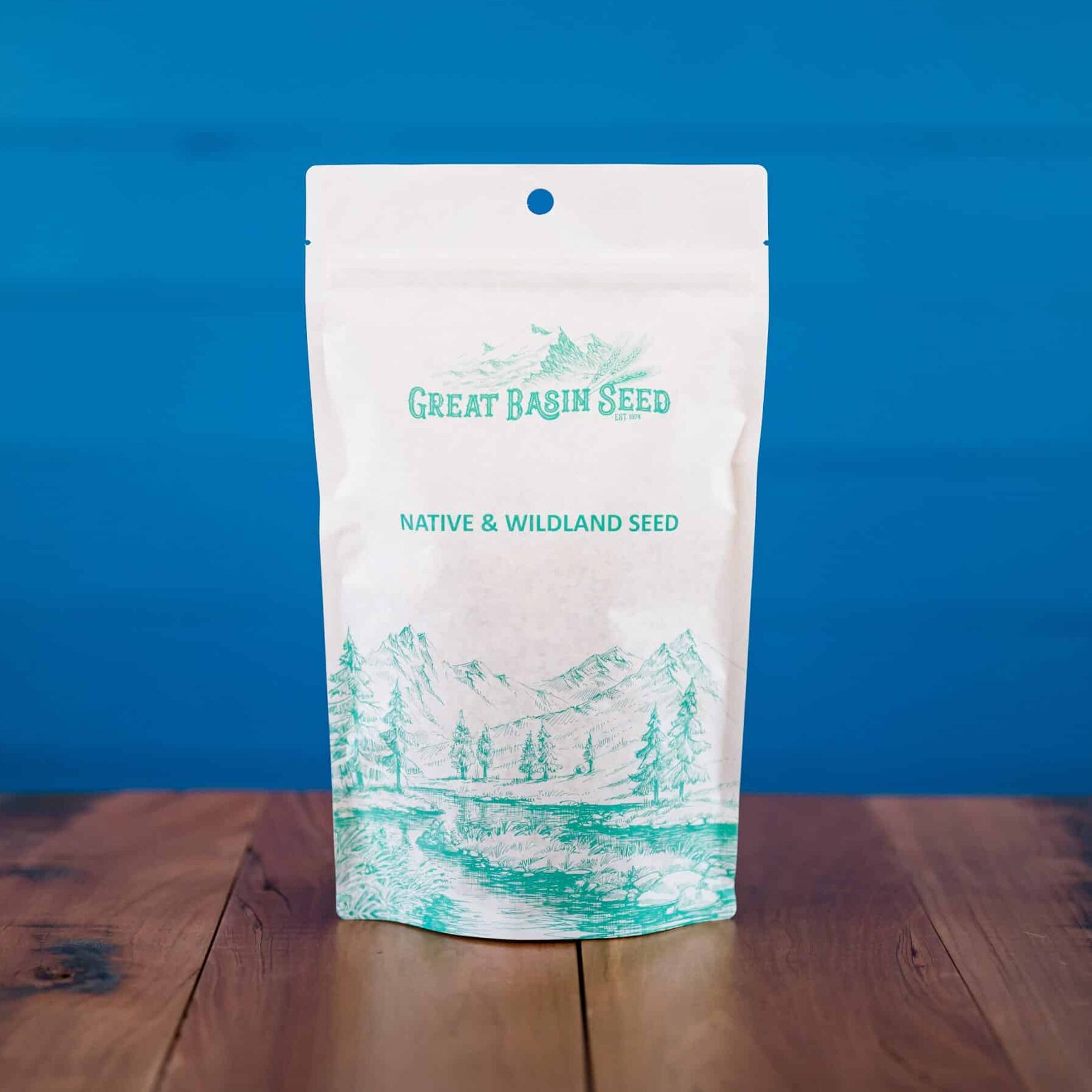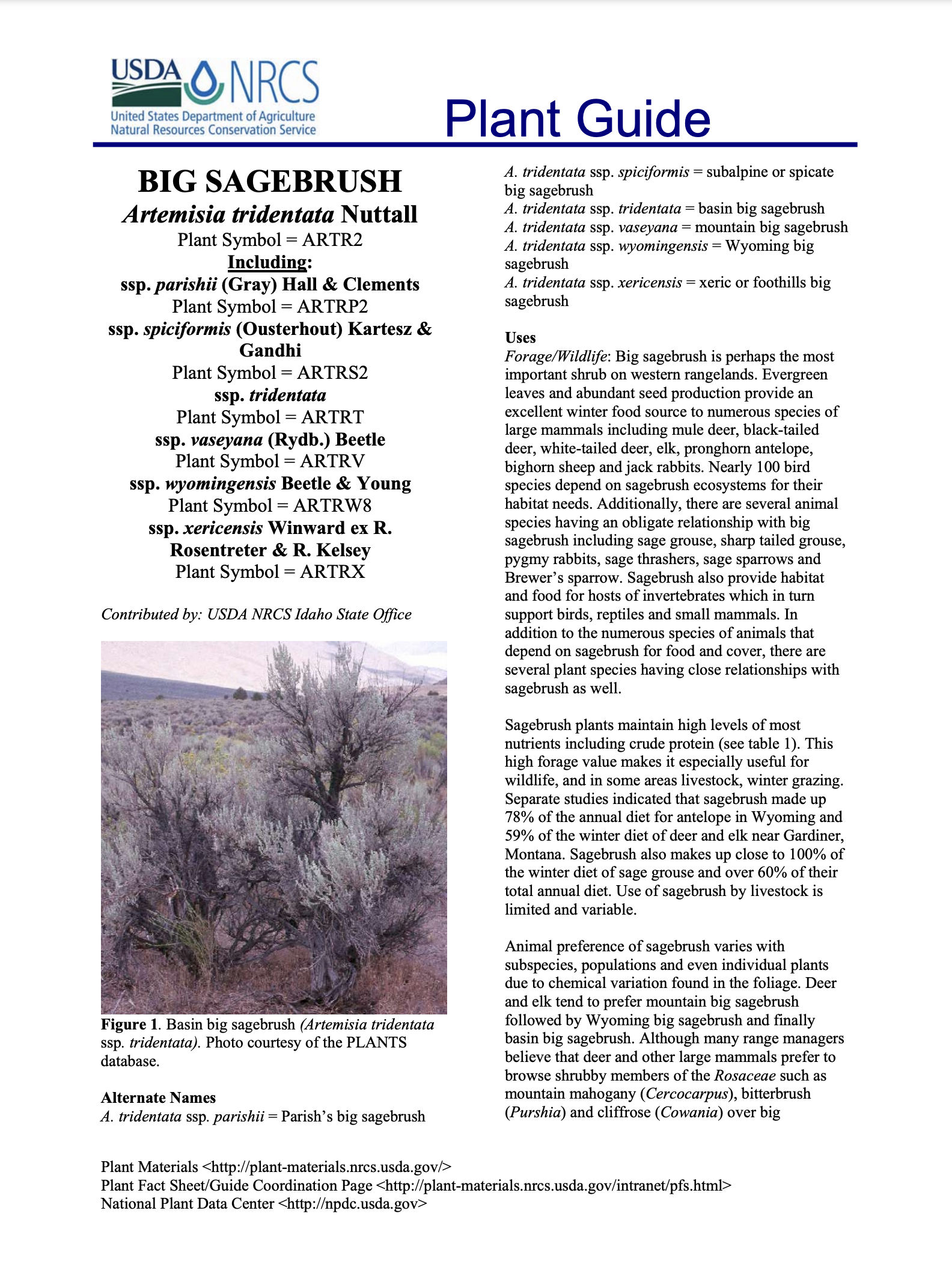







Wyoming Big Sagebrush
 $2.40 – $18.98
$2.40 – $18.98 - Scientific name: Artemesia tridentata wyomingensis
- Blooms in the early fall
- Considerably smaller than full-grown basin big sagebrush
- Most drought tolerant of the big sagebrush subspecies
- High forage value, especially useful for wildlife
- Important species in revegetation efforts
- Critical Sage Grouse habitat species
Min. to Max. Annual Precipitation
48in.
Average Max. Height
Perhaps the most important shrub on western rangelands. Critical species in sage grouse habitat. Adapted to well-drained fertile or infertile shallow soils on benches, lower slopes and plains. Adapted to a wide range of precipitation zones and soil conditions. Well adapted to the arid plains, valleys, foothills and mountains of the West in 8 – 30″ zones. Very important species for use in revegetation efforts.
Wyoming Big Sagebrush (Artemsia tridentata wyomingensis) is adapted to well-drained fertile or infertile shallow soils on benches, lower slopes and plains. Palatability is poor for cattle, fair for sheep and good for wildlife. Provides valuable cover for birds and small mammals. Blooms in the fall. Big sagebrush are evergreen shrubs ranging in size from less than 2 ft tall to as large as 13 ft tall. Wyoming Big Sagebrush is a highly valuable Sage Grouse habitat species.
Big Sagebrush (Artemesia tridentata wyomingensis) is adapted to a wide range of precipitation zones and soil conditions. Wyoming big sagebrush overlaps in range and elevation with basin big sagebrush. Plants are considerably smaller than those of basin big sagebrush, usually less than 3 ft tall, and have main stems branching from the ground. Flowering stems are not as widely branching as those of basin, but otherwise closely resemble that subspecies.
Plants are well adapted to the arid plains, valleys, foothills and mountains of the West where annual precipitation ranges from as little as 8 inches to as much as 30 inches. It is often found growing in loamy to sandy loam soils, but plants are found on all soil textures. Tolerance to alkalinity or acidity varies by subspecies. In general big sagebrush will grow in soils with a pH of 5.9 to 10.0 and with organic matter content of 0.62 to 4.14 percent.
Wyoming big sagebrush (Artemesia tridentata wyomingensis) grows at low to intermediate elevations between basin and mountain big sagebrush, but also commonly overlaps in range with the other two subspecies. When found in proximity with basin big sagebrush, Wyoming sagebrush will occupy the shallower, better-drained soils. Like basin big sagebrush, Wyoming is typically found in large stands covering many acres. Plants are also found in juniper, rabbitbrush, bitterbrush and mountain mahogany communities. At lower precipitation areas it is sometimes intermixed with shadscale and other Atriplex species. Wyoming big sagebrush commonly occurs from 800 to 2,200 m (2600 to 7,200 ft) in elevation. Wyoming big sagebrush is the most drought tolerant of the big sagebrush subspecies and is commonly found growing on low valley slopes and foothills receiving between 200 and 300 mm (8 to 12 in) annual precipitation. It occupies loamy soils with high clay content and a depth of 25 to 75 cm (10 to 30 in). Soils may be quite rocky or gravelly, but in these cases plants will be smaller.
Big sagebrush (Artemesia tridentata wyomingensis) is perhaps the most important shrub on western rangelands. Evergreen leaves and abundant seed production provide an excellent winter food source to numerous species of large mammals including mule deer, black-tailed deer, white-tailed deer, elk, pronghorn antelope, bighorn sheep and jack rabbits. Nearly 100 bird species depend on sagebrush ecosystems for their habitat needs. Additionally, there are several animal species having an obligate relationship with big sagebrush including sage grouse, sharp tailed grouse, pygmy rabbits, sage thrashers, sage sparrows and Brewer‟s sparrow. Sagebrush also provide habitat and food for hosts of invertebrates which in turn support birds, reptiles and small mammals. In addition to the numerous species of animals that depend on sagebrush for food and cover, there are several plant species having close relationships with sagebrush as well.
Sagebrush plants maintain high levels of most nutrients including protein. This high forage value makes it especially useful for wildlife, and in some areas livestock, winter grazing. Studies indicated that sagebrush made up 78% of the annual diet for antelope in Wyoming and 59% of the winter diet of deer and elk near Gardiner, Montana. Sagebrush also makes up close to 100% of the winter diet of sage grouse and over 60% of their total annual diet. Use of sagebrush by livestock is limited and variable.
Deer and elk tend to prefer mountain big sagebrush followed by Wyoming big sagebrush and finally basin big sagebrush. Although many range managers believe that deer and other large mammals prefer to browse shrubby members of the Rosaceae such as mountain mahogany (Cercocarpus ledifolius), Bitterbrush (Purshia) and Cliffrose (Cowania) over big Sagebrushes value as thermal or security cover is also very high for wildlife. This includes nesting cover and escape cover for sage grouse, sharp tailed grouse, pheasants, chukar and other upland birds.
Big sagebrush plants provide many additional benefits to the plant community. The dense canopy protects understory herbaceous plants from grazing. Healthy sagebrush communities provide a multi- tiered ecosystem with high levels of biodiversity. Big sagebrush plants also have a two-part root system with a deep tap root and a shallow, diffuse root system. Numerous studies have shown sagebrush plants create “hydraulic lift” where deep soil moisture is brought to near the soil surface by the tap root system during the day and then released into the upper soil at night. This water is then available to the diffuse root system of big sagebrush as well as to the roots of other understory plants. Sagebrush plants also increase water retention by trapping and holding windblown snow.
Big sagebrush subspecies are often useful indicators of soil characteristics. Generally, a subspecies indicates the soils at a site, thus proper identification of big sagebrush at a subspecific level can provide useful information on soils and ecological site characteristics. In some areas, however, such as those with glacial deposits, a separation based on soil characteristics is considerably more complex
Seed of big sagebrush are best adapted to germinate in habitats with ecological conditions approximating those of the seed collection site. Seed source and subspecies should always be seriously considered prior to seeding. It may be necessary to use seed from more than one subspecies in a given revegetation project to ensure adequate establishment in all habitats.
Seed should be sown in the late fall or early winter and allowed to naturally stratify. It should be noted that big sagebrush seed has special seed storage requirements. If stored in conditions with relative humidity above 30 percent, seeds lose vigor and germinability after two or three years. To ensure a greater chance of establishment success, check the viability of seed lots before planting.
Seed should be planted into a firm, weed-free seedbed at a depth of no more than 1/8 inch. Seed covered too deeply with soil will generally fail to establish. Best results come from surface broadcast seed that has been pressed into the soil to provide for good seed-soil contact. Seed can also be broadcast directly onto snow with good results. Pressing broadcast seed into the soil surface with a land imprinter has provided very good establishment success. Land imprinters create good contact between the seed and soil as well as provide microhabitats that optimize temperature and water requirements. Broadcast seeding has also yielded good results when followed by a cultipacker or drag chain.
Wyoming Big Sagebrush is the most important and critical Sage Grouse habitat species.
Drill seeding can be successful, but strict attention must be paid to seeding depth. Optimal drilling depth is 0 to 1/8 inch.
***Click on the “Quick Plant Facts” tab above for more information.
Big Sagebrush NRCS Plant Guide and Fact Sheet
Big Sagebrush NRCS Plant Guide and Fact Sheet
PDF version of NRCS Plant Guide & Fact Sheet
Prepared By: Derek J. Tilley, Range Conservationist, USDA NRCS
Plant Materials Center, Aberdeen, Idaho
Dan Ogle, Plant Materials Specialist, USDA NRCS
Idaho State Office, Boise, Idaho
Loren St. John, Manager, USDA NRCS Plant
Materials Center, Aberdeen, Idaho
Brock Benson, Area Range Conservationist, USDA
NRCS, Ogden, Utah
Species Coordinator: Dan Ogle, Plant Materials Specialist, USDA NRCS
Idaho State Office, Boise, Idaho
Pocket Guide to Sagebrush
Pocket Guide to Sagebrush
PDF version of Point Blue Conservation Science
Prepared By: Leila Shultz, Utah State University
Illustrations By: Linda Ann Vorobik
Design & Layout By: Scott Gillihan
Helpful Links
Additional information about this product can be found on the academic websites linked below.
Synonyms
Many plants have more than one common and scientific name. We've listed a few of them below.
- Wyoming Big Sagebrush
- Artemisia tridentata subsp.
Who is Great Basin Seed?
Great Basin Seed is a seed company that specializes in seed sales and consultation for home, ranch, farm, range and reclamation. We have been a leader in the seed industry since 1974.
Our History
We've been in the seed business since 1974.
What We Offer
We offer seed for home, farm, ranch, range and reclamation projects.
Meet the Gang
We have the best employees in the world! We are proud of the work they do, and trust them to serve you!
Right: Company founder Lloyd and his wife Paula Stevens in a wildflower seed production field circa 1977
Quick Plant Facts
| Common Name: | Wyoming Big Sagebrush |
|---|---|
| Scientific Name: | |
| Lifespan: | |
| Plant Type: | |
| pH Tolerance: | |
| Seed Count | 2500000 |
| Planting Rate: | |
| Min. Precipitation | 8 inches |
| Best Time to Sow: | |
| Max Sowing Depth: | |
| Growth Season: | |
| Sun & Shade Tolerance: | Full sun, tolerates shade |
| Hardiness Zones: | |
| Select a Package Size and Quantity | 1 oz. Envelope, 4 oz. Pouch (0.25 lbs.), 8 oz. Pouch (0.50 lbs.), 1 lb. (by the pound) |













